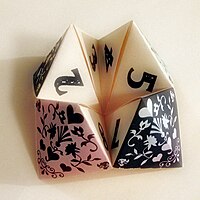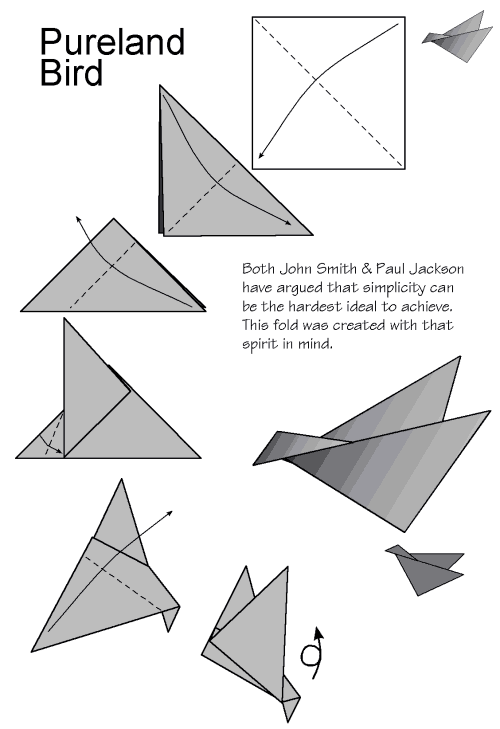I do not own many origami books, but I like to search online about many books and websites. Because there are many ways of foldings for one subject, many books were categorized by certain themes such as aircrafts, dinosaurs, toys, animals, and money folds.

"Awesome Origami Aircraft Models of the World's Best Fighters" by Tem Boun includes the foldings of the model airplanes which aren't flying type, but simulating real fighter airplanes. The models require retangular papers, and would be best with thin strong paper or foil. The author included some new techniques and maneuvers which may interest some explorers.

"Origami Fantasy" by Fumiaki Kawahata includes many extremely challanging models, mostly dinosaurs, but also includes pegasus, a mythological winged horse. Many of the models easily take more than an hour to complete. A reviewer added the stegosaurus took him more than four hours to complete! This book is recommended to the folders who are well experienced and like to explore challenging origami. By the way, I personally want to own this book!

"The Guide to Hawaiian-Style Money Folds" by Jodi Fukumoto is a book full of paper money origami. The book includes information about types of currency to use, dimension calculation, and explanations on the folding symbols. Each diagram has text explanations in different colors for easy notice. The models also utilize the features of the bills which result nice-looking designs on the finals. Fukumoto also has published "The Guide to American Money Folds" which includes the Christmas tree and the Staute of Liberty. Many reviewers say both of the books worth the price.

"Origami Zoo" by Robert J. Lang and Stephen Weiss contains many different kinds of animals. The models are vary in levels, simple to complex. and the book includes a detailed guide of symbols and procedures used in diagrams.

"Origami USA" is a website that contains many information about its organization and good resources on Origami. You can easily find popular diagrams and links to other well-known websites. There are many origami collections as other people have posted that you can view and get inspired.
"Robert J. Lang Origami" is a website of Lang who invented many figures in various types of origami including insects, animals, and mathmetical figures. It includes pictures of his complements and diagrams. His origami is very detailed and well shaped like real objects.
As many people enjoy playing with papers, it is very easy to find good websites that fit your level. I hope more people find origami a good source to kill their spare time and maybe get more interest in it.

 In order to get some feedbacks, I visited a school, Banneker Charter School in Cambridge, MA. I went to Kindergarten, 2nd grade, 4th grade, and 6th grade classes to show them how to make origami. Of course, I taught them things I included in my book. I taught caterpillars and dancing octopus to Kindergarteners, dancing octopus and airplane to 2nd graders, airplane and boat to 4th graders, and boat and talking crow to 6th graders. Kids needed little bit of help from their teachers, but they mostly followed my direction well.
In order to get some feedbacks, I visited a school, Banneker Charter School in Cambridge, MA. I went to Kindergarten, 2nd grade, 4th grade, and 6th grade classes to show them how to make origami. Of course, I taught them things I included in my book. I taught caterpillars and dancing octopus to Kindergarteners, dancing octopus and airplane to 2nd graders, airplane and boat to 4th graders, and boat and talking crow to 6th graders. Kids needed little bit of help from their teachers, but they mostly followed my direction well. 
 Time with these kids really helped me how to explain each diagram in words. Since I had so much fun with them, I added their pictures of making things at the end of the book. The process was fun for me. I have sold about 10 books to my teachers and friends. They thought my book could be a good gift to children, their kids or cousins.
Time with these kids really helped me how to explain each diagram in words. Since I had so much fun with them, I added their pictures of making things at the end of the book. The process was fun for me. I have sold about 10 books to my teachers and friends. They thought my book could be a good gift to children, their kids or cousins.




 Origami tessellations is growing popularity these days but already have a long history refering as far back as the Ancient Egypt. Such technique was applied on their fabric. Tessellation is the pattern of shapes arranged side by side with no gaps in between. And origami Tessellations use a piece of flat paper to fold into such patterns without any gaps. Shuzo Fujimoto have organized and published few books on origami tessellations in the late 1960's. Now, we can easily find more information about their history, their diagrams, and their application in mathematics, fashion, and science industries.
Origami tessellations is growing popularity these days but already have a long history refering as far back as the Ancient Egypt. Such technique was applied on their fabric. Tessellation is the pattern of shapes arranged side by side with no gaps in between. And origami Tessellations use a piece of flat paper to fold into such patterns without any gaps. Shuzo Fujimoto have organized and published few books on origami tessellations in the late 1960's. Now, we can easily find more information about their history, their diagrams, and their application in mathematics, fashion, and science industries.





 6. Your octopus will dance with legs moving.
6. Your octopus will dance with legs moving.






